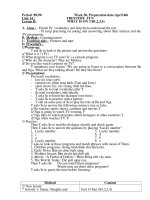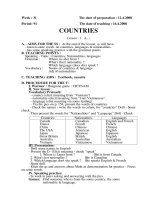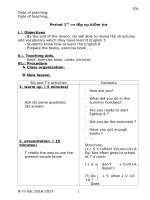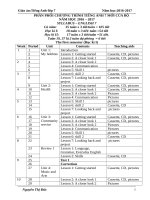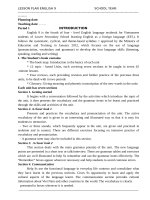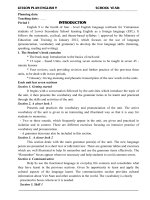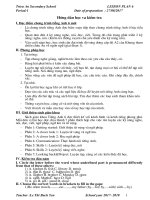GIAO AN ANH 9THI DIEM
Bạn đang xem bản rút gọn của tài liệu. Xem và tải ngay bản đầy đủ của tài liệu tại đây (360.91 KB, 13 trang )
Ob.ectivex:
By the end of this unit, students can:
• use the lexical items related to dishes, and
ways of preparing and cooking food
• ask statement questions with the correct
intonation
• use some quantifiers correctly
• write and use conditional sentences type 1
with modal verbs
• read for general and specific information
about the eating habits of Japanese
people
• talk about the eating habits of Vietnamese
people
• listen for detailed and specific information
about teenagers’ eating habits
• write about the eating habits of a classmate
GETTING £TARTED
G
My fÞvourite sÞlÞd
M
Introduction
Ask Ss what their favourite dishes are. Elicit
answers from Ss and quickly write them on the
board.
Write the unit title on the board: ‘Recipes and
eating habits’. Ask Ss to explain the meaning
of recipe and eating habits. After Ss give their
answers, explain briefly:
– recipe (n): a set of instructions that tells you
how to cook something and the ingredients
(items of food, herbs, spices, etc.) you need for
it
Unit 7/ Recipes and Eating Habits
7
– eating habits (plural noun): the way a person
or group eats, considered in terms of what
types of food are eaten, in what quantities,
and when
Now start the lesson.
Have Ss answer the questions as a class.
Reference for teachers: Pronunciation of some dishes
Play the recording and have Ss follow
along. After that, Ss can compare their
answers with the information in the
dialogue and add some more details to
their answers.
Cobb salad /kαb' sælad/
curry /'kxri/
fajitas /fa'hi;tas/
steak pie /ste.k pa./
lasagne /la'zænja/
sushi /'su;f/
Unit 7/ Recipes and Eating Habits 6T-7T
Þ
Have Ss work independently to find the words with the given meanings in the dialogue. Allow Ss to
share their answers before asking them to discuss as a class. Remember to ask Ss to read out the lines
in the dialogue that contain the words. Quickly write the correct answers on the board.
Key: 1. starter
2. versatile
3. drain
4. peel
5. chop
6. combine
Have Ss look at the Watch out! box and quickly read the information. If time allows, ask Ss to make some
examples with the expressions.
b Ask Ss to work in pairs and complete the word webs. Call on one pair to write their answers on the
board.
Other pairs add more words if needed.
boil
salt
mayonnaise
pepper
prawns
Ingredients
celery
c
lemon
juice
add
wash
mix
spring onion
Preparing combine
and cooking
chop
peel
drain
Have Ss read the questions to make sure they understand them. Ask them firstly to answer the
questions without reading the dialogue again. Have Ss exchange their answers with a classmate. Now
ask them to check their answers by reading the dialogue again. Ask for Ss’ answers.
Key: 1.
2.
3.
4.
5.
Nick’s mum.
Because it’s simple and delicious.
In the summertime.
They are versatile, and you can use lots of different ingredients in a salad.
Nick’s mum boils and drains the prawns. Nick washes the celery, peels the prawns, and mixes
the ingredients. Mi washes the spring onions, chops the celery and spring onions, and mixes the
ingredients.
6. Because he is finding it difficult to wait for one hour.
2 Have Ss look at the pictures. Tell Ss that in the box are some dishes from different countries in the world.
Ask Ss to match these dishes with the pictures, and then compare their answers in pairs. Play the audio for
Ss to check and repeat the answers.
Key + Audio script: A. Cobb salad
E. lasagne
3
B. sushi
F. mango sticky rice
C. steak pie
G. beef noodle soup
D. fajitas
H. curry
Þ Have Ss work in pairs to discuss what country in the box is associated with each dish in 2. Check and
confirm the correct answers.
Key: A. The USA
B. Japan
C. The UK
D. Mexico
E. Italy
F. Thailand
G. Viet Nam H. India
b Tell Ss to complete the sentences with the names of the dishes in 2. The complete sentences will give Ss
information about these dishes. Call on two Ss to write their answers on the board.
If time allows, T may organise a short activity to check Ss’ short-term memory. Have Ss close their books.
Point at each of Ss’ answers on the board and quickly Ss have to call out the country where the dish comes
from.
Key: 1. Lasagne
2. curry
3. steak pie
4. Fajitas
5. sushi
4 Ask Ss to work in groups to do the quiz. The group which has the answers the fastest is invited to read
out their answers. Elicit feedback from other groups and ask them to add some other answers.
If there is some time left, have Ss work in their groups and write down a similar quiz. Set a time limit
of about five minutes. When time is up, ask the first group to read out a question in their quiz. Ss
from other groups give the answer. Other Ss decide if their answers are correct. Continue the activity
until all the groups have read out all of their questions or when time is up.
Suggested answer:
1. beef
2. prawn, potato
3. cheese, butter, ice cream
4. strawberry, lychee, cherry, pomegranate
5. broccoli, spinach, lettuce, celery, kohlrabi
Unit 7/ Recipes and Eating Habits 8T
A GLOÊER LOOH 1
Ơocịbmlịry
Ask Ss to call out some verbs for preparing and cooking foods they remember from the previous lesson.
Tell them that in this lesson they are going to learn some similar verbs. These will help them use the
language correctly when talking about recipes.
1 Have Ss work individually to do this exercise and then compare their answers with a classmate.
Elicit the answers from Ss and quickly write them on the board. Do not confirm the correct answers at
this stage. Have Ss explain the meaning of each verb in English or Vietnamese. Correct Ss’
explanations when needed.
– whisk:
beat eggs, cream, etc., with a special tool to add air and make the food light (đánh
trứng, kem…)
– slice:
cut something into thin flat pieces (thái lát)
– grate:
rub food (e.g. cheese) against a grater in order to cut it into very small pieces (nạo)
– dip:
put something quickly into a drink, sauce or batter and take it out again (nhúng)
– chop:
cut something into pieces with a knife (chặt, cắt)
– spread:
put a layer of a substance evenly onto the surface of something (phết)
– sprinkle:
shake small pieces of something, or drops of a liquid, on something (rắc)
– marinate: pour a mixture, usually containing oil, wine or vinegar, and herbs and spices, over meat
or fish before it is cooked to add flavour or make it tender (ướp)
Now have Ss look at their answers on the board and say if these are correct.
Key:
A. chop
B. slice
C. grate
D. marinate
E. whisk
F. dip
G. sprinkle
H. spread
2 Thepurposeofthisexerciseistohelp Ssusetheverbscorrectlytotalkaboutfoodpreparation. Ask Sstowork
in pairs to do the exercise. Check the answers as a class. If time allows, have Ss make sentences.
Key:
1. chop; Slice
2. grates; sprinkles
3. Marinate
4. whisk
5. Dip
6. spread
3 Have Ss do this exercise individually and then compare their answers with a partner. Check and confirm the
correct answers. Have Ss give the Vietnamese translation of the words if needed.
Key: 1. g
4
Þ
2. f
3. h
4. c
5. e
6. a
7. d
8. b
Ask Ss to answer the two questions. Elicit their answers. Ask them if they have ever eaten or made a
pizza. If Ss have eaten pizza, ask them if they like the dish. If they have made a pizza themselves, ask
them to describe the process of making one briefly.
Key:
tomato sauce, onion, cheese, apple, bacon, pizza base ‹ pizza
Unit 7/ Recipes and Eating Habits 9T
b
Have Ss complete the instructions individually and then compare their answers with a partner. Check
the answers as a class. Ask Ss who have not made a pizza before if they can make a pizza themselves
after reading the instructions.
Key:
1. Chop
2. Grate
3. Spread
4. Sprinkle
5. Spread
6. Bake
PronmnciÞtion
Tones in statements used as questions
Explain to Ss the meaning of ‘statement’ (a telling sentence that ends with a full stop) and ‘statement
question’ (used to check information; has the order of a statement but ends with a question mark).
Play the part of the conversation in GETTING STARTED which includes a statement question. Ask Ss to
pay attention to the intonation of the sentences. Ask them to give comments.
Now have Ss read the information in the REMEMBER! box. Answer any questions from Ss, and ensure that
Ss understand the information.
5 Ask Ss to read through the three conversations. Play the recording for Ss to draw appropriate arrows to
indicate the intonation of each sentence. Have Ss compare their answers in pairs. Call on some pairs to
read the conversations out loud. Correct any mistakes.
For a more able class, have Ss work in pairs and draw the arrows first. Then play the recording for them
to check their answers.
Audio script + Key:
1. A: What do we need to make a pizza?
B: A pizza base, some cheese, some bacon, an onion, and an apple.
A: An apple?
B: Yes, an apple.
2. A: What’s for dinner?
B: We’re eating out tonight.
A: We’re eating out?
B: Right.
3. A: I can’t eat this dish.
B: Why not?
A: I’m allergic to prawns.
B: Allergic to prawns?
A: Yes, my skin turns red when I eat them.
6
Þ Ask Ss to work in pairs to complete the mini-dialogues with suitable statement questions. Call on some
pairs to write their answers on the board. Give comments when needed.
b
Have Ss practise the dialogues and act them out in front of the class with the correct intonation.
Ask other Ss to comment.
If time allows, let Ss write their own dialogues with statement questions.
Suggested answer:
1. You don’t like pasta?/Don’t like pasta?
2. Add some salt?
Unit 7/ Recipes and Eating Habits 10T
A GLO£ER LOOH 2
GrÞmmÞr
Quantifiers: review
Ask Ss what a quantifier is. If needed, briefly explain to them that a quantifier is a word or phrase that
expresses quantity or amount. Tell Ss that they have already learnt, and know, quite a few quantifiers.
Elicit examples from Ss.
T may organise a short warm up activity with this content. Ss work in pairs to write down all quantifiers
they know in two minutes. The winner is the pair which has the most answers.
1 Ask Ss about the use of the four quantifiers. Make any necessary comments. Have Ss do this exercise
individually and then compare their answers in pairs.
Key:
1. a
2. a
3. some
4. some/any
5. a
6. some
7. an
8. any
9. some
Tell Ss that when talking about recipes people usually use food quantifiers and that the Look out! box
contains the most common ones.
Have Ss read the information in the Look out! box. Explain any unclear points. If time allows, ask Ss to give
examples with the quantifiers. Ss may also add some more food quantifiers they know to the list.
2 Have Ss do the exercise individually and then compare their answers with a partner. Remind them
that some quantifiers can go with more than one noun. Check the answers as a class.
Key:
1. a, g
3
Þ
2. a
3. f, g
4. c
5. h
6. b, d
7. e, f
8. b
Have Ss work in pairs to read the instructions to make a chicken salad and to fill each blank with a
word/ phrase from the box. Check as a class.
Key:
1. 200 grams
b
2. an
3. tablespoons
4. teaspoon
5. teaspoon
6. some
Ask Ss to work in pairs, and think about a simple salad they know. Together Ss write the instructions to
make it. Call on some pairs to read aloud their instructions. Other Ss listen, make comments, and vote
for the best salad.
T may also organise a competition. Have Ss work in groups to write the instructions to make a
salad on a big piece of paper. Once they have finished, each group sticks their instructions on the
board. A board of five Ss act as examiners. This board reads the instructions and gives each group a
mark.
Unit 7/ Recipes and Eating Habits 11T
Modal verbs in conditional sentences type 1
4 Have Ss read the two given sentences and answer the questions. Elicit their answers and confirm the
correct ones.
Key:
1. ability
2. advice
Ask them to give the standard form of conditional sentences type 1. T may call on one student to write the
form on the board. Now have Ss read the information and examples in the grammar box. Write the form of
the examples on the board:
If + S + V (present simple), S + can/must/may/might/should + V (infinitive).
5 Have Ss do the exercise individually and then compare their answers in pairs. Ask some Ss to read out
loud the complete sentences.
Key: 1. c
2. e
3. a
4. b
5. f
6. d
6 Have Ss work in pairs to read the situations and write appropriate if-sentences. Call on some Ss to write
their sentences on the board. Give necessary correction.
If time allows, organise a quick game. Ss work in groups and write down two situations. After five minutes,
have a representative from one group stand up and read out one situation. This student points at a random
student in another group to give a conditional sentence type 1 with a modal verb. If the sentence is
correct, the group gets one point. The groups take turns to read their situations. The winner is the group
with the most points. Make sure the groups have equal opportunities to give the answers.
Suggested answers:
1.
2.
3.
4.
5.
If you want to have good health, you must reduce the amount of salt in your food.
If my brother is hungry, he can eat three bowls of rice.
You can take a cooking class if it is at the weekend.
If I eat this undercooked pork, I may have a stomachache.
You should whisk the eggs for 10 minutes if you want a lighter cake.
GOMMUNIGATION
Tell Ss that in this lesson they will have the opportunity to learn how to cook one kind of soup.
Go through the extra vocabulary with Ss. If Ss do not know any word in the box, quickly teach
it. To teach the words shallot and cube, T may draw the pictures on the board. To teach other
words, use simple explanations and examples or give definitions.
– purée (v): make fruit or vegetables into a thick, smooth sauce, usually in a blender
– garnish (v): decorate a dish of food with a small amount of another food
– tender (adj): soft or easy to chew e.g. ‘my grandmother can only eat beef if it is tender, so my
mother has to stew it for one hour’
1 Have Ss look at the picture and answer the questions. Quickly elicit their answers and write them on the
board. Do not confirm the correct answers now.
2
Þ Play the first part of the recording for Ss to check their answers. Confirm the correct ones.
Key: 1. pumpkin, celery, shallots, butter, salt, cream
b
Play the recording again for Ss to do the exercise. Have them compare their answers in pairs. Call
on two Ss to write their answers on the board. Ask other Ss to correct these answers if needed.
Play the recording one more time for Ss to check their answers.
Audio script (part
1):
Pumpkin soup is my family’s favourite soup. We usually have it for breakfast with some slices of
bread. It’s quick and simple to cook.
The ingredients are: a kilo of pumpkin, two shallots, two sticks of celery, two tablespoons of butter,
two tablespoons of fresh cream, and a pinch of salt.
Before cooking, peel the
pumpkin and chop it
into cubes. Peel the
shallots and slice them.
Next, wash the celery
and remove the leaves.
Key: 1. a kilo/one kilo
6. a pinch
3
2. two
7. peel
3. two sticks
8. chop
4. two tablespoons
9. peel
5. two tablespoons
10. slice
11. leaves
Þ+b
Have Ss read the steps to cook the soup and try to rearrange the steps. Ask some Ss to write their
order on the board. Play the recording for Ss to check their answers. Ask Ss to comment on the orders on
the board. If there are any unclear points, play the recording a second time.
Key: 1. b
c
2. e
3. f
4. c
5. a
6. d
Without playing the recording again, ask Ss about the benefits of the soup. If Ss are not sure about
any points, play the recording again. Have one student talk about the benefits.
Key: - a good source of fibre, minerals, and vitamins, especially vitamin A.
- improve your eyesight and protect yourself from certain cancers
Audio script (part
2):
4
Here are the steps to make the soup:
– Heat the butter in a deep pan, add the shallots and celery and stir fry for a few minutes.
– Add the pumpkin and stir fry for a few more minutes.
– Add 750ml of water and a pinch of salt and cook until the pumpkin is tender. Cool for 10 minutes.
– Purée the soup in a mixer until it is smooth.
– Add the cream and simmer for 2 to 3 minutes.
– For the finishing touch, garnish it with some celery leaves.
Pumpkin soup is very healthy. It’s a good source of fibre, minerals, and vitamins, especially vitamin A. If
you eat this soup regularly, you can improve your eyesight and protect yourself from certain cancers.
Þ Have Ss work in groups to discuss a dish they like. Ss take notes of the ingredients, how to prepare the
b
dish, and the steps to cook it on a big piece of paper. Move around to provide any necessary help.
Ask groups to stick their answers on the walls around the class. Ask other Ss to move around to
each group and listen to the group’s presentation about the dish. Have Ss vote for the best dish and
explain the reasons.
Unit 7/ Recipes and Eating Habits 13T
£HILL£ 1
ReÞding
1 Have Ss work in pairs to discuss the questions. Elicit their answers. Because it is an open activity, accept
different answers.
Suggested answers:
Picture A: different types of sushi
Picture B: miso soup
Picture C: a bowl of
rice
Picture D: sliced cucumber/pickled cucumber
2 Ask Ss to read the headings quickly. Make sure they understand the meaning of each heading.
Now Ss read the paragraphs and match them with the headings. Ask them to compare their answers
with a classmate. Elicit their answers.
Key:
A. 3
B. 2
C. 1
3 Have Ss read the passage again to answer the questions. Ss can underline parts of the text that help them
with the answers. Ask Ss to compare their answers before giving the answers to T. Ask them to give
evidence when giving the answers.
Key:
1.
2.
3.
4.
5.
6.
They like raw food and do not use sauces with a strong flavour.
They cut fresh fish.
Both can be served with soy sauce.
There are four (rice, soup, main dish, pickles).
Rice is the staple food and is very nutritious.
Because the dishes are presented in different bowls and plates, and are arranged carefully
according to a traditional pattern.
£peÞking
This part helps Ss understand more about the eating habits of Vietnamese people.
4 Have Ss work in groups to discuss the eating habits of Vietnamese people. Ss use the questions provided
as cues. Move around the class to provide help. Ask the groups to organise their ideas to prepare for a
short presentation.
5 Have one group of students act as examiners and other groups as competitors. The groups take turns
to
present their ideas. If there is not much time left, allow about two or three groups to present. Invite
comments from the examiners. Give additional comments.
Reference for teachers (this note provides some general information; T can add more specific
details to match the context of each area)
Vietnamese eating habits
Vietnamese food is varied and distinctive. It is considerably low fat and high in carbohydrates. Traditional
Vietnamese cooking usually uses fresh ingredients, little dairy and oil, and various herbs and vegetables.
Different sauces such as fish sauce, shrimp paste, and soya sauce are quite popular in various regions.
There is no concept of ‘courses’ in a Vietnamese meal. A meal consists of various dishes: main dish
(meat, fish, egg or tofu), vegetable, soup and rice. Rice is the staple in Viet Nam. In many families, people
eat around a tray of food with a small bowl of fish sauce in the middle. Around this bowl are the dishes.
If people place the food on a table, a similar arrangement is followed. Dishes are served communally.
Usually there is a big dish/bowl of each dish, and people use chopsticks and spoons to get their share.
In general, Vietnamese food is considered healthy and is popular in other countries.
Unit 7/ Recipes and Eating Habits 14T
£HILL£ 2
Lixtening
1 Have Ss do this activity in pairs. They ask each other questions to find out the differences between the two
pictures. Elicit the answers from Ss. Ask them to describe the underlying meaning of the pictures.
Suggested answers:
- Picture A: A boy is eating chocolate. On the table there are junk foods such as
crisps, a hamburger, soft drinks, and sweets. The boy looks fat.
- Picture B: A girl is having rice. On the table we can see soup, fish, vegetables,
and watermelon. The girl looks slim and fit.
- Meaning: They show the contrast between healthy eating and unhealthy eating.
2
3
Tell Ss that they are going to listen to two students talking about their eating habits. Before listening,
Ss read through the statements to make sure they understand them and to underline key words. Play
the recording for them to do the exercise. Call on one student to write the answers on the board. Ask
other Ss if they agree with them. Play the recording a second time for Ss to check. Don’t confirm the
correct answers now.
Withoutlisteningtotherecordingagain, Sscomplete thetablebyfillingeachblankwithnomore thanthree
words. Have Ss compare their answers with a classmate before giving T the answers. Ask two Ss to write
their answers on the board. Play the recording one last time to confirm the answers for both 2 and 3.
Key:
2 1. T
3 1. biscuits
6. cereal
2. F
2. hamburger
7. a banana
3. T
3. crisps
8. slices of bread
Audio script:
Nicolas: I don’t have a proper breakfast. I never have time
because I always get up late. Normally, my mum buys a packet of
biscuits and I have some on the school bus. At lunchtime, I’m
always hungry, so I have a hamburger, a packet of crisps, and a
cola. I can easily get them at the school canteen. For dinner, I like
fried beef, noodles, and eggs. I don’t really eat vegetables
because they aren’t tasty. My mum says my eating habits are
unhealthy. I’m thinking about changing them. If I continue eating
like this, I may become overweight.
4. F
4. fried beef
9. boiled egg
5. T
6. F
5. vegetables
10. steamed fish
Maya: My brother doesn’t have healthy eating habits, but I
do. For breakfast, I usually have a bowl of cereal, a glass of
milk, and a banana. It’s important to start a new day with a
good breakfast, so I tend to have nutritious things. I don’t
buy lunch at school; instead, I prepare my lunch box with two
slices of bread, a boiled egg, and salad. Sometimes, my mum
makes sushi for my lunch. In the evening, my mum and I cook
dinner. My favourite is steamed fish. Lean grilled chicken is
also a dish I like for dinner.
Writing
4
Ask Ss to work in pairs. They ask and answer questions about each other’s eating habits, and take notes of
their partner’s answers in the table.
After that give Ss a few minutes to read their notes again to answer the questions provided.
T should move around to give comments as there may not be enough time for checking with the whole
class. 5 Þ+bAsk Ss to write about their partner’s eating habits. When they have finished, Ss exchange
their writing to spot any mistakes. Have Ss share the mistakes with the whole class. T may collect some
Ss’ work to mark
at home, or T may ask them to rewrite the exercise as homework. In this case, remember to ask for Ss’
revised work in the next lesson.
Sample writing:
My friend, Trang, does not have healthy eating habits. She sometimes skips breakfast. When she has it,
she usually buys a hamburger and a soft drink from a café near our school. For lunch, her favourite is fried
rice and deep-fried chicken. The good thing is that she prefers to have dinner at home. However, she likes
eating a lot of rice and fatty pork for dinner. She rarely eats vegetables, but loves fruits.
I think Trang should change her diet. First, if she wants to have more energy for the day, she should never
skip breakfast. Second, she must reduce the amount of fast food she eats. Also, eating more vegetables
would be good for her. She should also eat less rice for dinner. These changes will definitely keep her fit.
Unit 7/ Recipes and Eating Habits 15T
LOOHING BAGH
Encourage Ss not to refer back to the unit. Ask them to keep a record of their answers to each
exercise so that they can use that information to complete the self-assessment box at the end of
the unit.
Ơocịbmlịry
1 Have Ss do this exercise individually and then compare their answers with a partner. Call on Ss to read
out loud their answers.
Key:
1. d
2. e
3. g
4. b
5. a
6. c
7. h
8. f
2 Ask Ss to complete the words individually. Check Ss’ answers as a class. If time allows, call on one or two Ss
to write their answers on the board.
Key:
A. steam
E. roast
B. deep-fry
F. grill
C. stir fry
G. simmer
D. bake
H. stew
3 Ask Ss to do this exercise individually. Have some Ss read out their answers. Confirm the correct ones.
Key:
1. hamburger
2. sushi
3. deep-fry
4. steam
5. stew
GrÞmmÞr
4 Have Ss do this exercise individually. Check the answers as a class. T may ask Ss to explain their choice.
Key:
1. slice
2. sticks
3. any - some
4. bag
5. clove
6. bunch
5 Ask Ss to write the sentences individually. Have two Ss write the sentences on the board. Ask other Ss
to give comments. Correct the sentences if needed.
Sample answers:
1. If you keep eating fast food, you might become overweight.
2. If you promise to finish your homework tonight, you can go to the cinema with your friend.
3. He should eat less sweets if he doesn’t want to have toothache.
4. She must eat less rice and bread if she wants to lose weight.
5. If you join this cooking lesson, you can cook many delicious dishes.
Unit 7/ Recipes and Eating Habits 16T
GommmnicÞtion
6 Have Ss rearrange the lines to make a complete conversation, first individually and then share their
answers with a partner. Ask some pairs to read out loud the conversation.
Key:
1. B
2. E
3. F
4. I
5. A
6. H
7. J
8. C
9. G
10. D
Finished!
Ask Ss to complete the self-assessment. Identify any difficulties and weak areas and provide further
practice if necessary.
PROJEGT
A survey on eÞting hÞbits
The project helps Ss to learn more about their schoolmates’ eating habits. To gain the best
results, tell Ss about the project early in the unit (i.e. when you teach the Communication
section), so that
they have enough time to gather and analyse the information. Activities 1 and 2 can be done as
homework.
1 Have Ss work in groups of four or five. They go to other classes and ask different Ss about their eating
habits. To reduce the workload, each student interviews three other Ss and records their answers in the
table. This should be done early in the unit.
2 Group members meet together and organise the answers in the form of an answer to each question.
The following table can serve as an example. This summarises the answers of 12 Ss (Ss work in groups of 4).
Question
St 1
St 2
St 3
St 4
St 5
St 6
St 7
St 8
St 9 St 10 St 11 St 12
1. How often do you eat fast
food?
2. How often do you eat
homemade food?
3. How many meals do you
have per day?
4. Which meal is the most
important to you?
5. Which do you prefer: eating
at home or eating out?
6. What is your favourite dish?
Their findings might look like this:
– Question 1: Of 12 students answered, only three usually eat fast food. Four of them sometimes eat fast
food, and five never have this kind of food.
– Question 2: …
3 Have groups present their findings to the class. Finally, they conclude whether Ss at the school have
healthy eating habits.
Unit 7/ Recipes and Eating Habits 17T
